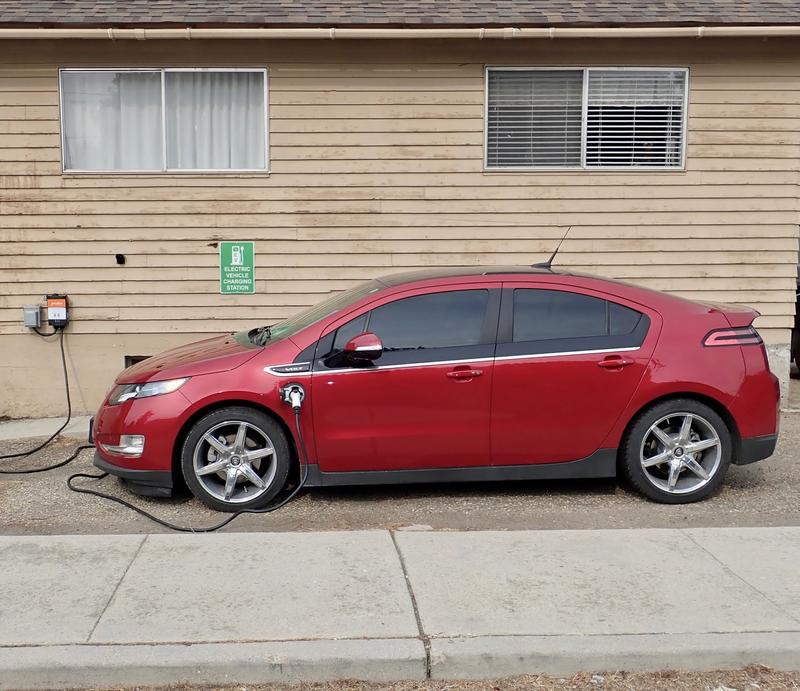I’ve installed a perfectly functional public EV charging station near downtown Nampa!
There’s 32A worth of 240V fury a couple blocks off downtown, set up with the EVMatch charging network, and the setup works great!
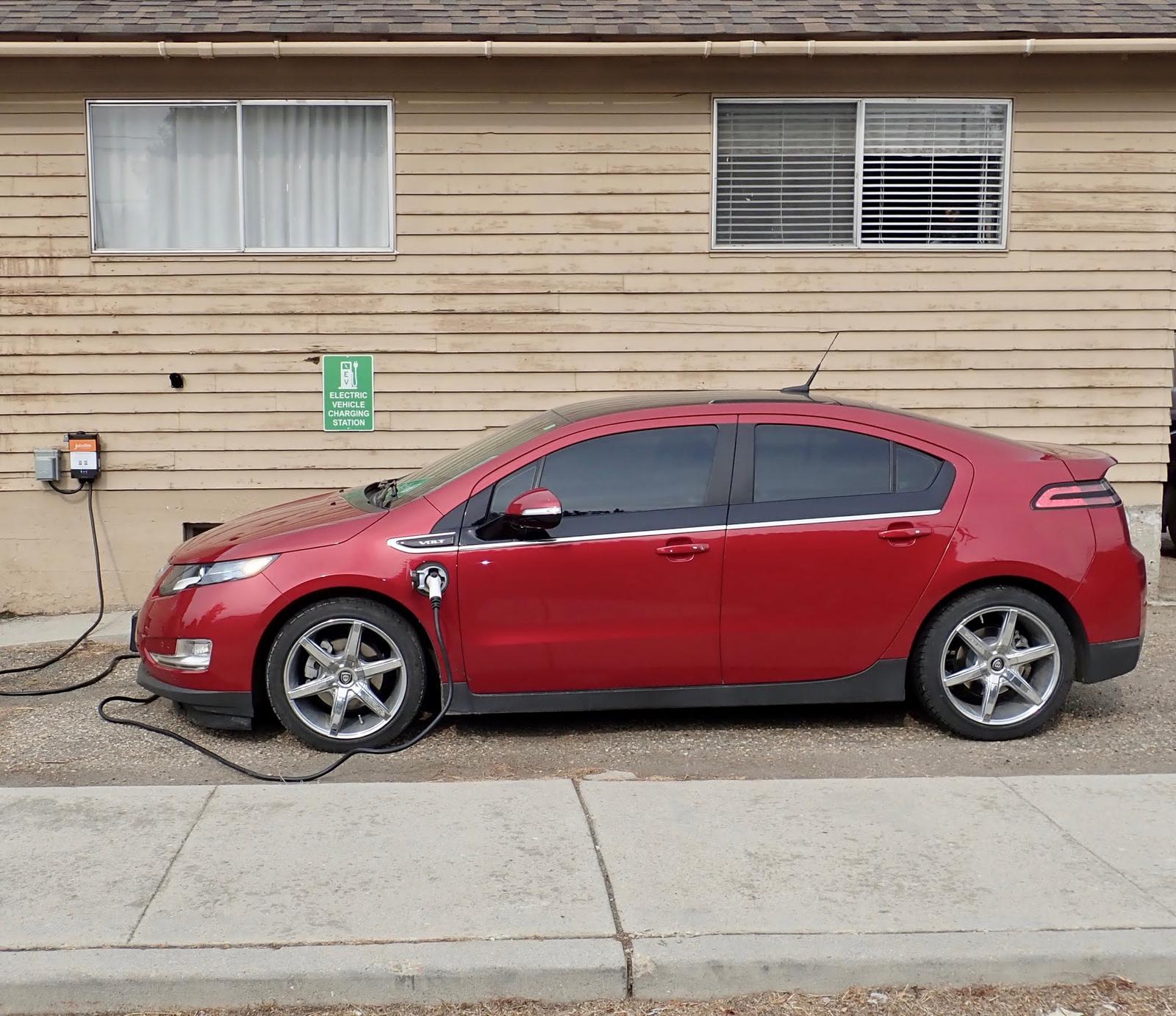
This has been an interesting, somewhat drawn out process - but if you’re looking to do something like this, you’ll find a bunch of useful information in here about what the process looks like.
Should you? Yes. You absolutely should.
A Public Charging Station?
Why on earth would I want to self-fund a public charging station? Partly as an experiment, partly because the area doesn’t have many public charging stations that aren’t at dealerships, and definitely not at all to get a halfway reserved parking spot at a place I find myself regularly. Another guy at church owns a Volt too, so we’ll have to work out details…
Two weeks ago, I mentioned that the public charging infrastructure in the Treasure Valley area wasn’t great. There’s a bit of a chicken and egg problem out here - there aren’t many EVs, so there’s not much charging infrastructure, which makes it a bit annoying to own a shorter range EV, etc. If I complain about something, I like to try and fix it - so I’ve made a contribution to the charging infrastructure out here!
See the lone charger in Nampa, southwest from the cluster of car dealerships up by the highway? That’s mine - and, importantly, it’s near downtown.
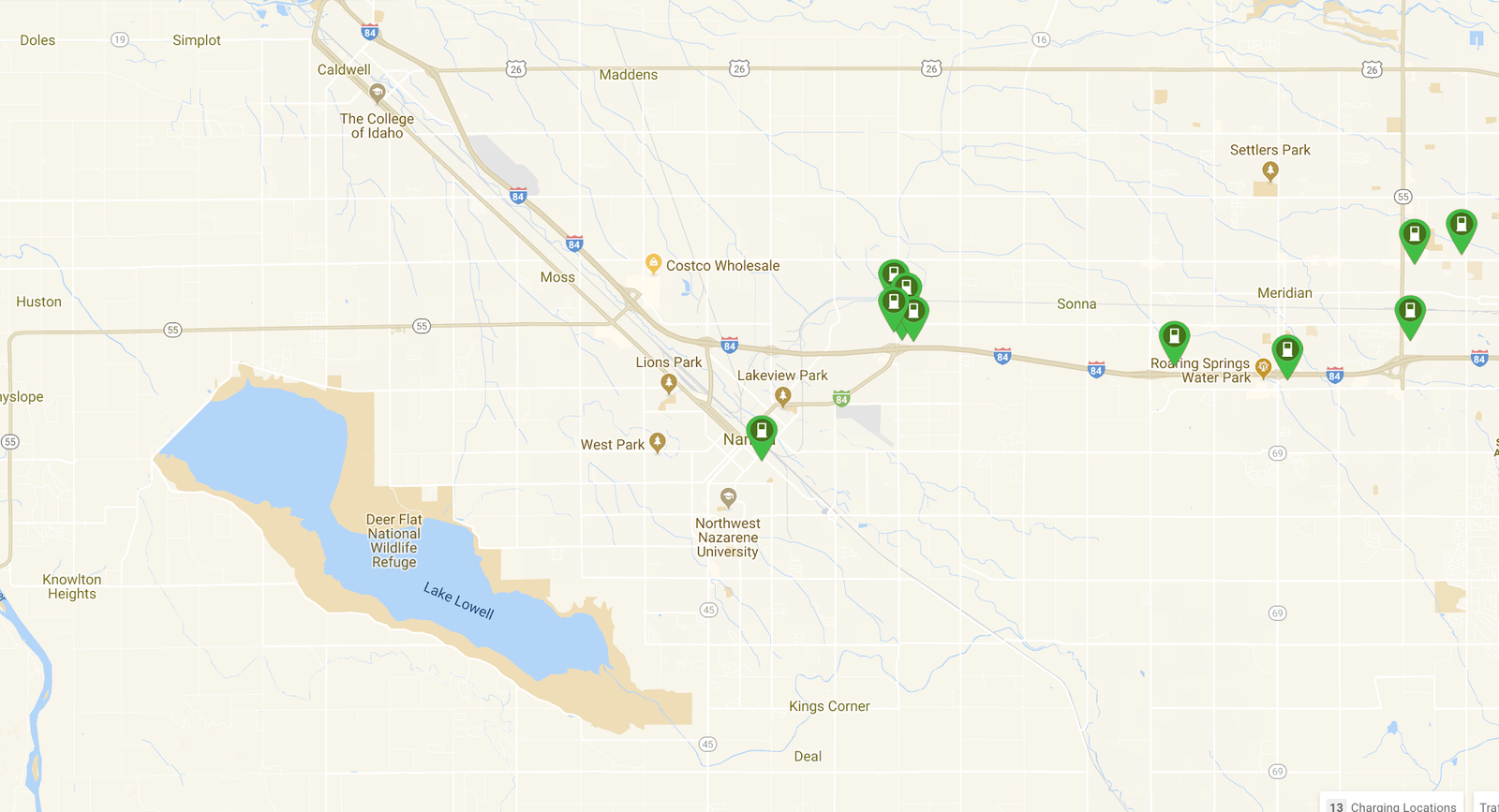
You can see the (confusing, diagonal) grid of downtown Nampa, with the brand new charging station right off the corner that marks the edge of downtown. It’s walking distance to downtown, it’s conveniently located in a place I find myself often enough, and it’s yet another new charging station in an area with very, very few public chargers.
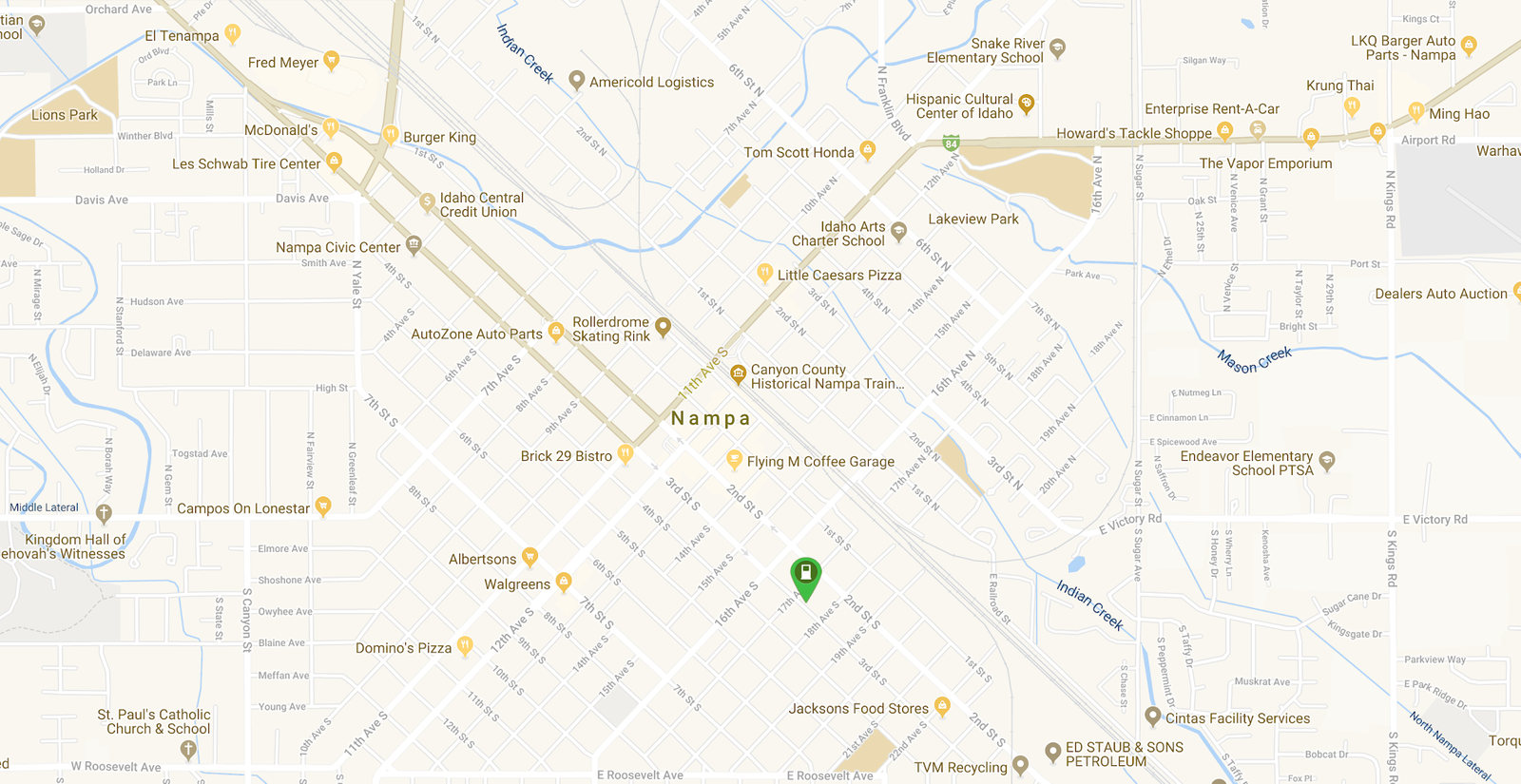
Importantly, this isn’t a car dealership. Car dealership charging stations are a pain - half the time they’re not what’s advertised, the dealerships don’t actually seem to like the stations being used (especially if you’re not a matching brand), and you’re often subject to someone trying to sell you cars (poorly) if you use one that doesn’t match your brand. Not a fan.
Actually, I don’t know anyone who’s had a good experience with car dealerships and electric cars or plug in hybrids. The attitude among salesmen seems to be that anyone who wants an EV is going to come in for that one thing only, so why bother learning anything about them? And, conversely, there’s no reason at all to sell an EV/PHEV/etc to someone who isn’t looking for one. I still think dealerships are useful, but would it kill them to actually get some salespeople who knew EVs?
This station is, however, on a 100 year old church building (or, at least, the 70 year old part of it)! To the best of my knowledge, we’re the first church building in the Treasure Valley with an EV charger, and church buildings with EV chargers are somewhat rare in the first place!
The Involve Training Center
The building is labeled as the Involve Training Center on various maps, and it’s owned by Involve Church - a local church plant in Nampa that’s been around for just over 4 years. We meet at a school, but we own a church building. This causes no end of confusion…
Size-wise, we simply don’t fit in the building we own. We’re too big of a congregation, and have too large of a Sunday School program. We meet at a local school on Sundays and set up in the gym every week. It’s quite the process. My weird DMX gizmos and the extreme XLR cables are for this, and all have been working quite well. The rugged XLR cables are the primary long run cables and show no signs of wear, while the DMX gizmos just work. We had to retune some settings based on new overhead LED bulbs (they don’t dim quite like the old ones), but that’s been it - otherwise, it just works.
This is also where my Little Neighborhood Library went up. I live out in rural farm country, so if there’s a project I want to do that benefits from population density, I just do it at the ITC!
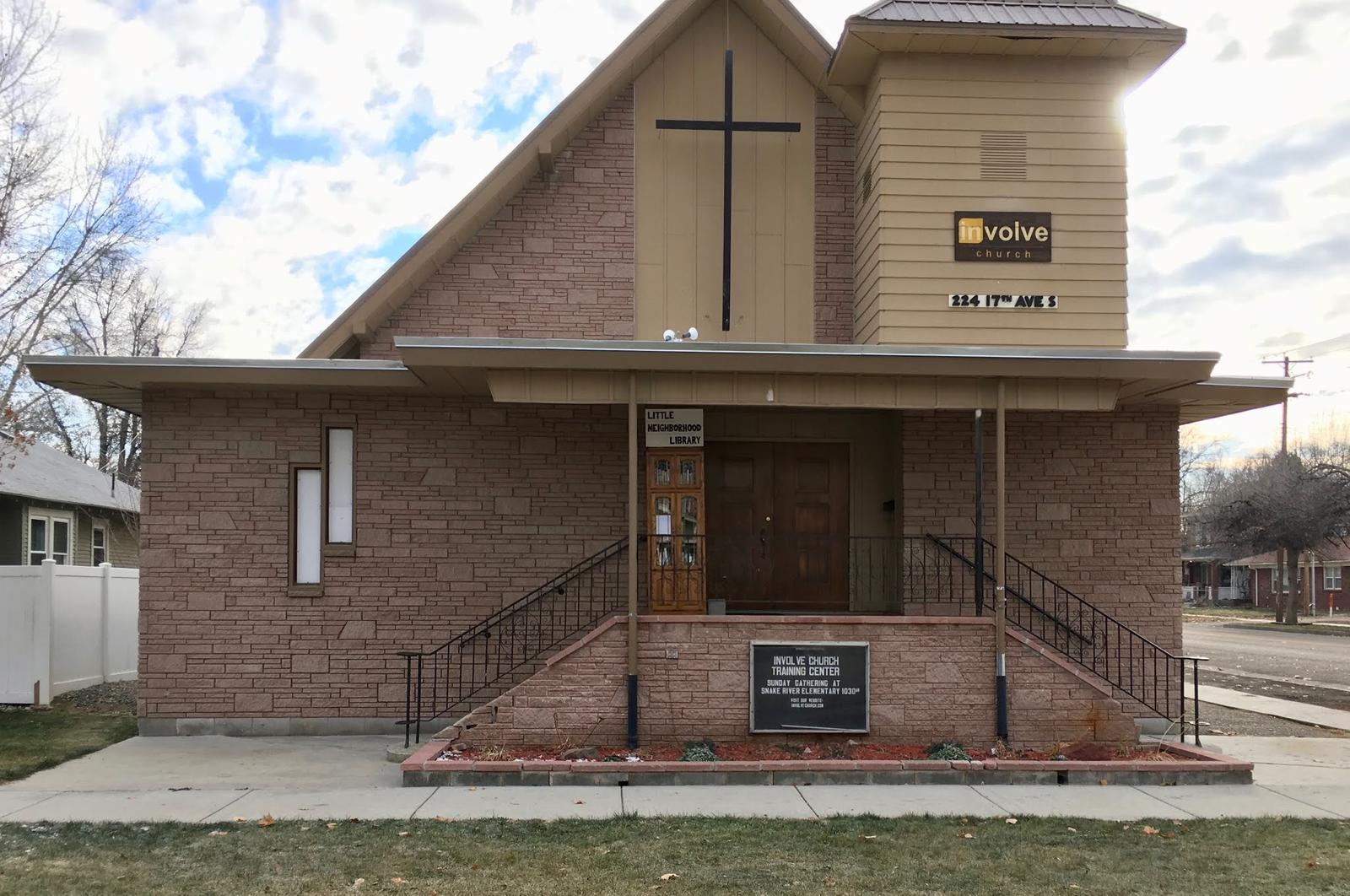
Our building, the Involve Training Center, has required an insane amount of work to renovate from the 1970s interior into something more modern and useful. We use it as office space, as spaces for mid-week meetings, and there’s a family living in the parsonage undergoing church planting training. It gets quite a bit of use, and it’s within short walking distance of downtown Nampa, which makes it a perfect spot for an EV charger! I would have preferred a location actually in downtown, but we own this building. My attempts to convince Nampa to put in a charger downtown have been met with a lot of “Yes, that sounds like a very good idea, we’ll consider it, thanks, bye!” sort of responses.
Charge Station Prerequisites: Power
There are several things a charging station needs. It needs power, it needs a place for a car, and it needs the actual charging hardware (the EVSE).
Power might be the trickiest for most places. For a public charging station to be of any use at all, it should be 240V (Level 2 charging), and ideally quite a few amps. A 240V/50A circuit is perfect, though if you cant manage that, lower amperages are still useful. A circuit can’t draw more than 80% of the rated amps for “continuous” use, which EV charging is defined as, so a 50A circuit is good for 40A max - or 9600W of charging. Relatively few EVs have more than 5-7kW of charging capability onboard, so 32A (7.7kW) from a 40A circuit is another reasonable way to go. You can get away with less, but it starts becoming rapidly less useful as you drop down in amps. I probably wouldn’t bother doing it if you can’t get at least 20A (4800W) out to a car - lower charging current is fine for home charging but just not as useful as a public charger.
Since I don’t live in this building, and we’ve got an electrician already doing a bunch of electrical work (we’ve upgraded the outdoor panel to support the new heat pumps, replaced a bunch of knob and tube wiring, etc), I just added another item to his queue - “Please run a 240V/50A outlet out towards the street side.” A month or two later, I got the invoice for the work (around $800), and had a nice fat outlet box where I wanted it! It’s got the standard NEMA 14-50 outlet you find for dryers, electric stoves, at RV parks, and in an increasing number of garages!
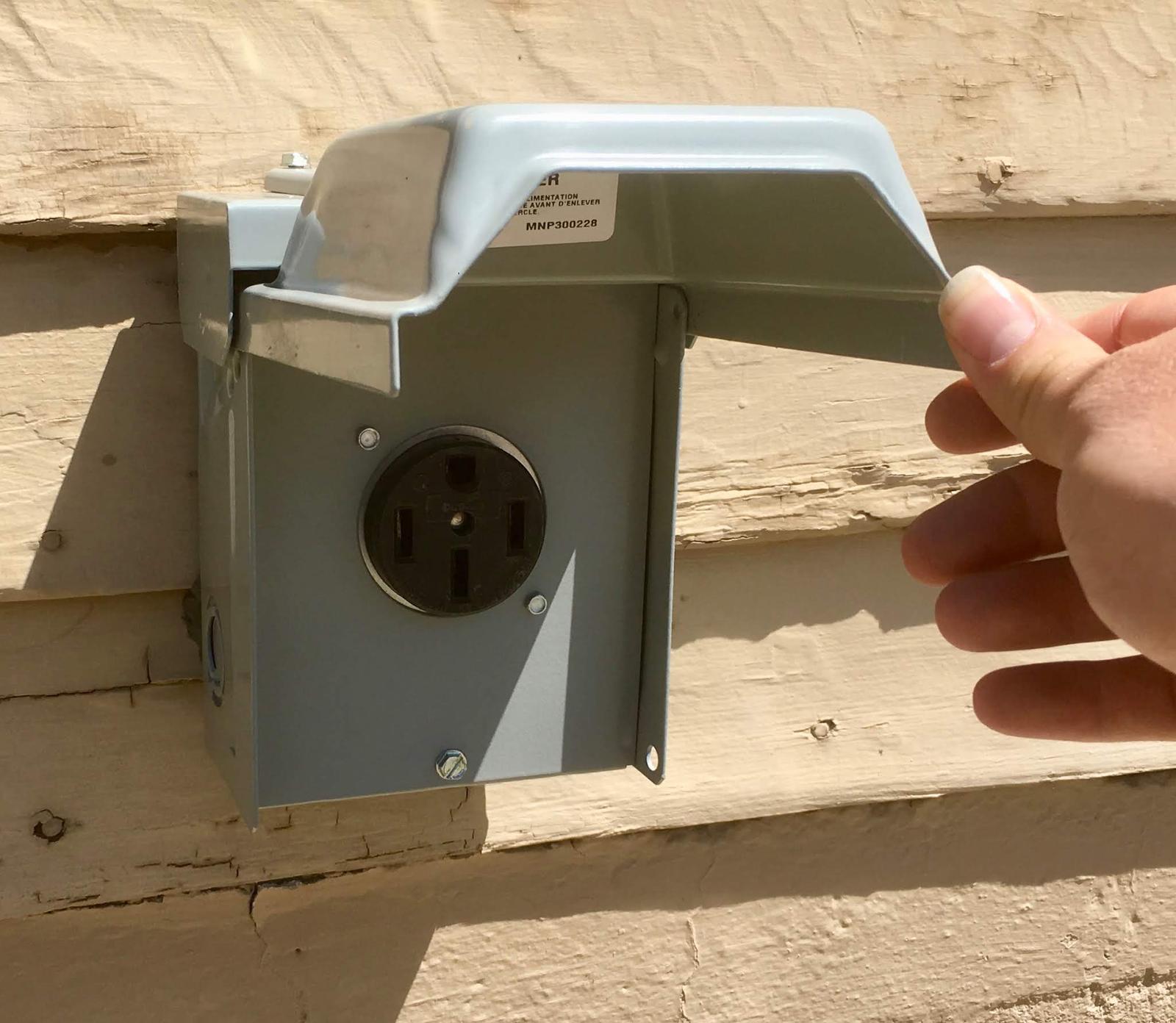
If I just wanted to charge myself there, I’d be done - I can build an adapter and charge. But that’s no fun, and it’s not terribly useful either. My own private outlet is nice, but I can do far better.
Charge Station Prerequisites: A Parking Spot
One of the reasons I’d been waffling on this project was because we just didn’t have a great spot to park cars to charge. There’s a parking area, but it’s a sidewalk away from the building, and while I have run cords over the sidewalk on occasion, it’s not something I want to do regularly. I’d picked up some “cord hiders” to help keep people from tripping on the charging cable as it crossed the sidewalk, but someone had a better idea. A car could park up next to the building, if it weren’t for some anchor points left over from an old, super sketchy access ramp that’s been torn down. You can see the concrete start of the ramp on the left below the outlet, and the concrete footings that contain tire-puncturing bolts heading off to the right. Yes, the siding needs replacing, and if you want to come help or donate for that, you’re more than welcome to!
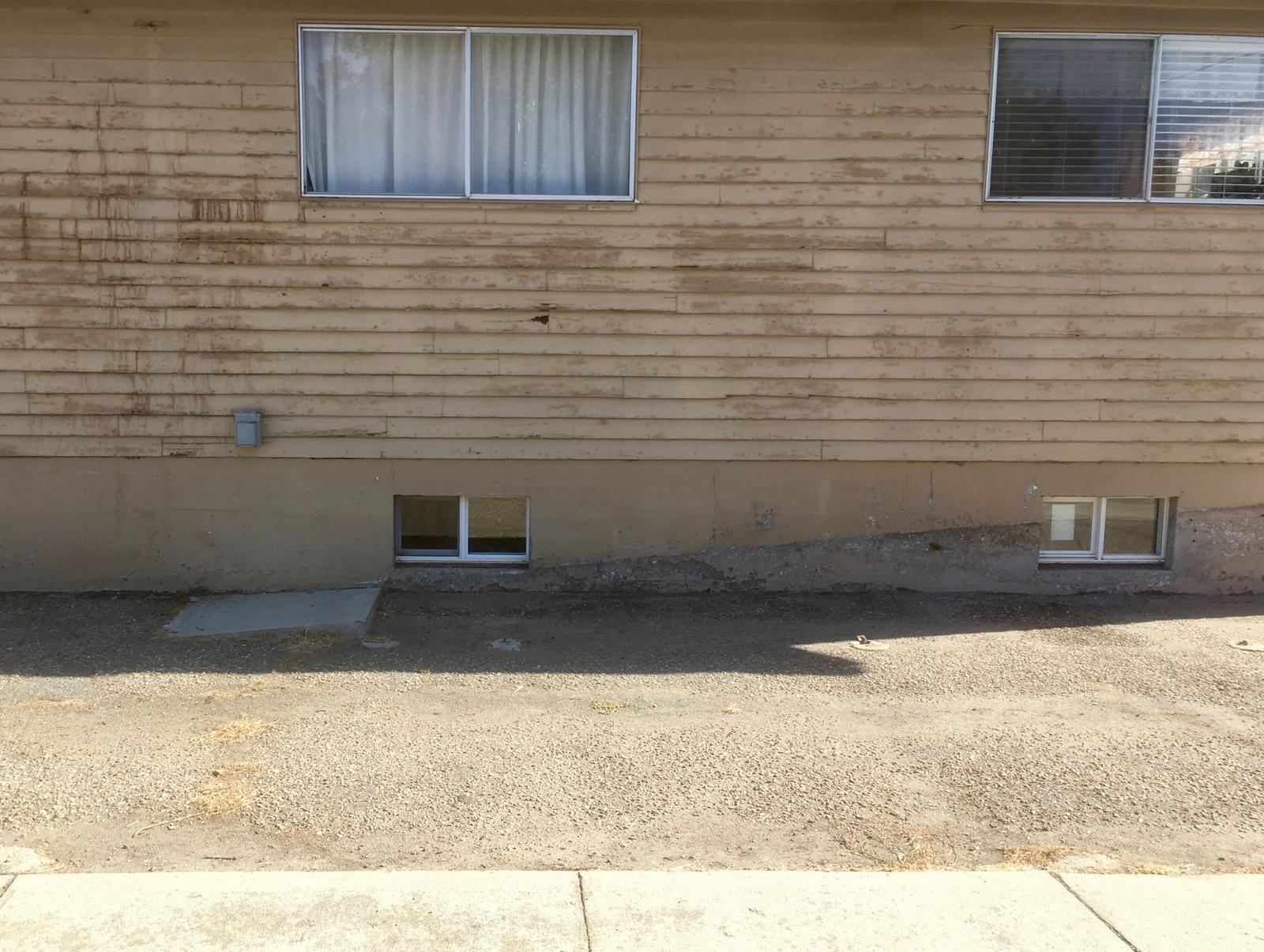
Beyond just the bolts, we had some pretty sketchy bits of sharp metal left over as well. They were out of the way for normal use, but not if you wanted to get a car along the building with intact tires.
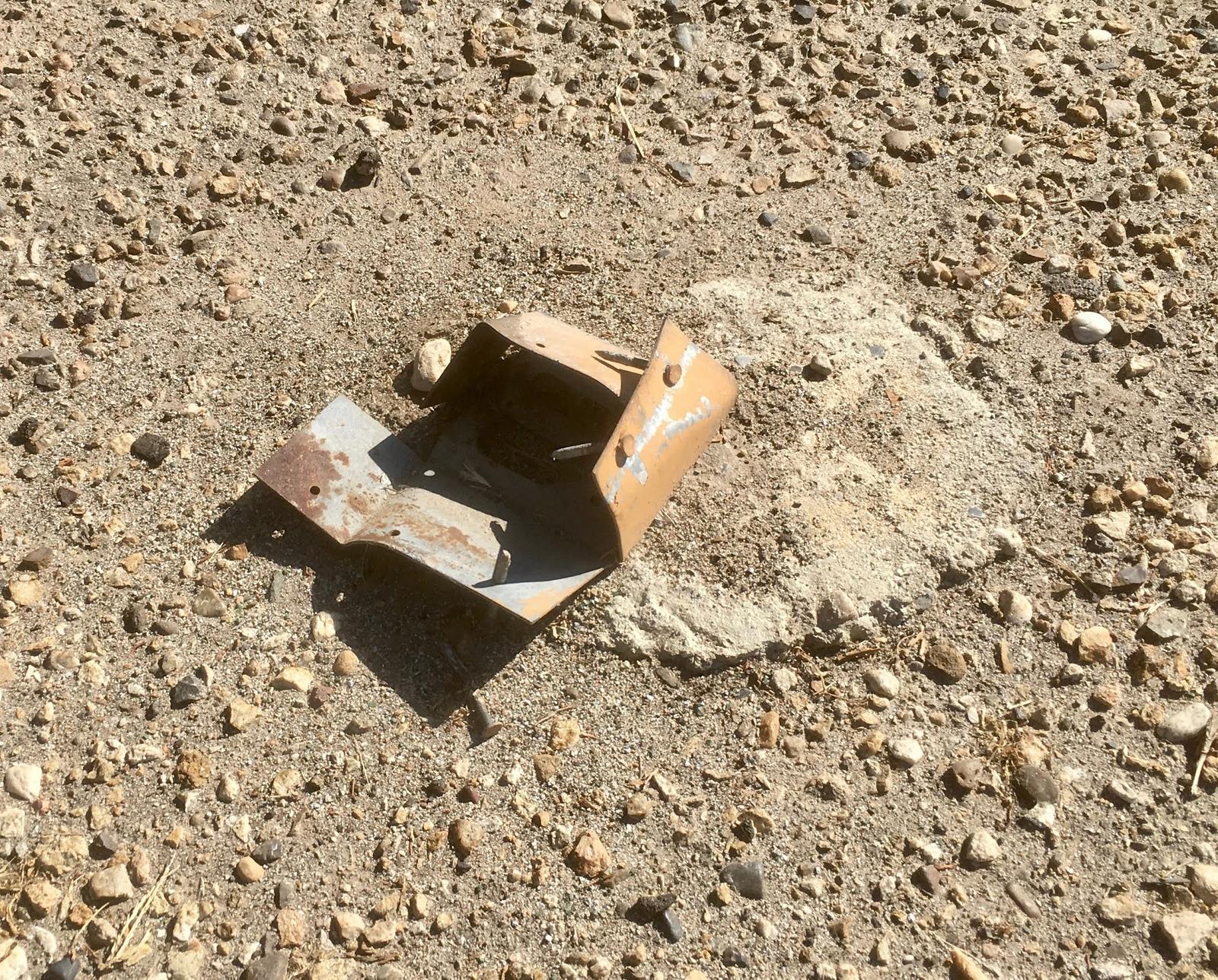
A good bit of love with a socket and driver got the remaining nuts and debris off, leaving bolt heads sticking out of the ground. If you’re finding yourself needing to remove nuts from bolts in the ground that have been rusted in place for decades, bring a good breaker bar. You might get lucky and snap some off at the ground!
How do you resolve bolt heads sticking out of the ground? With a grinder! I borrowed this bit of 1970s technology from a neighbor up the hill. It’s big, loud, insanely powerful, a bit of a nightmare to use compared to modern ones (I found out after I returned it that the trigger had been sticking for a while, though it behaved for me), and works perfectly to grind bolt heads off flush with the concrete.

Use water to cool the bolt head after you’ve ground it off. I’m not sure just how hot the bits got, but they were definitely on the “way, way too hot to move” side of the temperature scale until I cooled them down. Even after sitting for a few minutes in the air, the stubs I removed were quite hot (use gloves for a project like this). The metal was glowing quite red hot while smoothing it off, so it seems like pumping half a kW of mechanical energy into a tiny little bit of metal makes heat! Who knew?
I removed more bolt heads than I needed for a parking spot, and the people who live in the building full time were quite excited by their removal as well!

Charge Station Prerequisites: An EVSE
Contrary to a common misconception about EVs, they don’t just have a regular outlet plug inside the charge port. They (typically) use a J1772 connector for AC charging. It’s a slightly complex weatherproof plug that carries some useful signals about how many amps the car can draw. It also signals that the user is trying to unplug it so the car can stop charging before the plug is pulled, and it has some other handy features as well.
To manage this connector, a bit of electronics typically called an EVSE (Electric Vehicle Supply Equipment) is used. They can be quite simple if they’re designed for portable use (like the Duosida I keep in the back of our Volt for portable charging), or they can be quite complex. Many of the public EV charging stations have a nice big LCD display, RFID readers for charging keycards, cell connectivity for cloud… stuff, maybe a credit card acceptor. They’re fancy, and also staggeringly expensive. A dual outlet ChargePoint station with all those features is about $7000. They’re nice, but that rather exceeds my budget for this project.
For this install, I’ve got a 32A JuiceBox EVSE. This is a single outlet unit (just fine with me) that has some smart capabilities. It connects to the internet via wireless (no problem, the building has a network) and can be remotely controlled. It also keeps track of the power that’s gone through it and can report this in a variety of report formats. When the cloud backends for it quit, I’ll just figure out how to run a local interface to it. The JuiceBoxes also support outlet sharing. If this became some super popular charger, I could add another charger on the same 50A outlet, set up a load group, and the two would split the current properly. If there was only one car plugged in, it could pull the full current, but two would split it 50/50 to keep the outlet load at a safe level.
Why this unit? Why 32A of EVSE on a circuit that can handle a 40A charger? Because I got it for free. I’ll explain that a bit later, though. For now, it needs to be installed. This particular model comes with a 1’ cord to a 14-50 plug, which I’ll be shoving in the just-installed outlet.
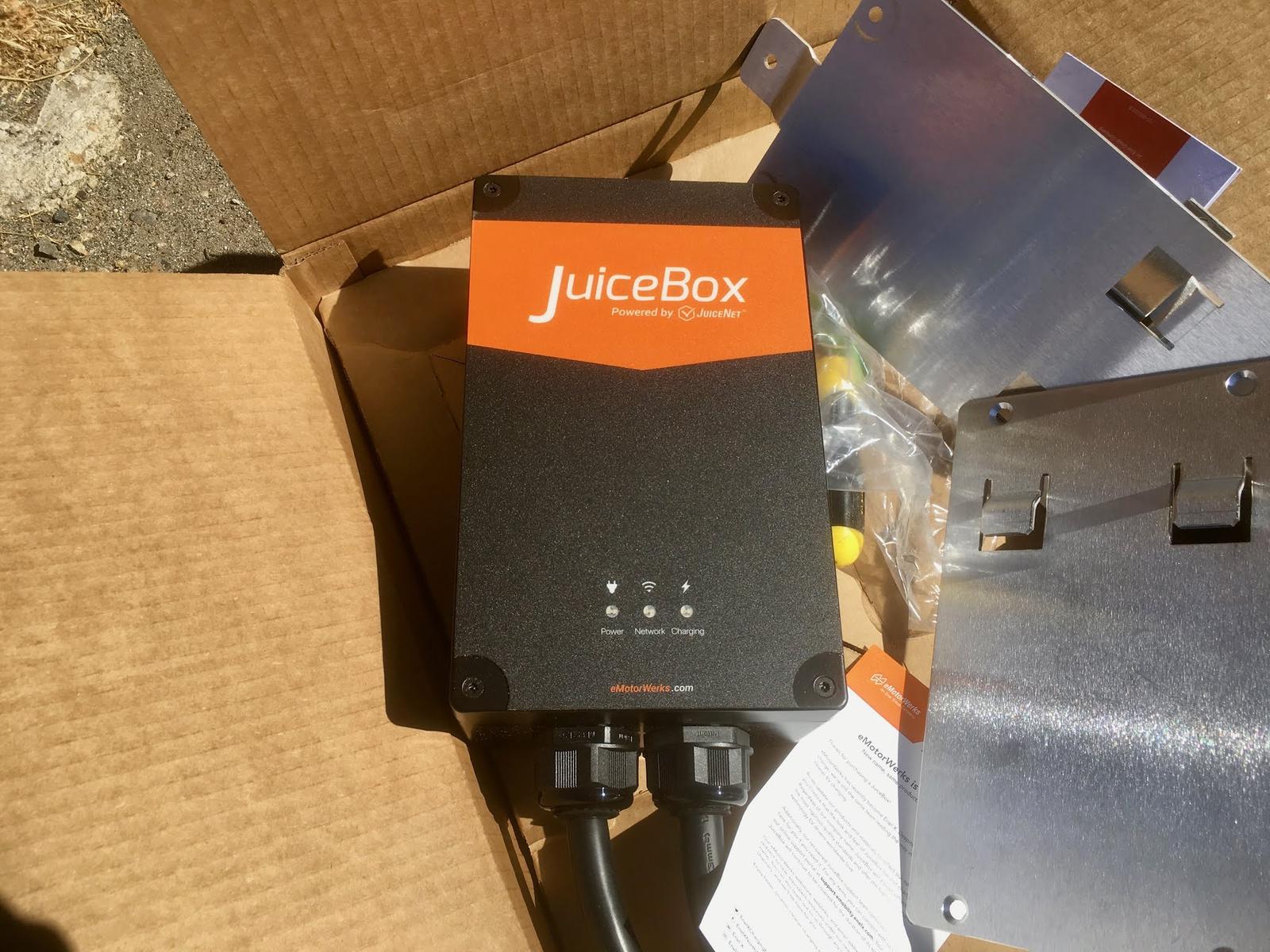
I paid a bit extra for the locking bracket. This lets me run a lock bar across the top with a little padlock to prevent someone from just lifting the unit off the wall and walking away with it. It won’t stop anyone particularly determined, but I’m just not that worried about someone wandering off with an EVSE out here. I probably wouldn’t do this if I lived in downtown Seattle or something, but here? It’s probably fine.
The bracket screws into the siding, though with stepped siding like this it’s important to not just crank it all the way down - you won’t get the bracket to slide in if you do that.
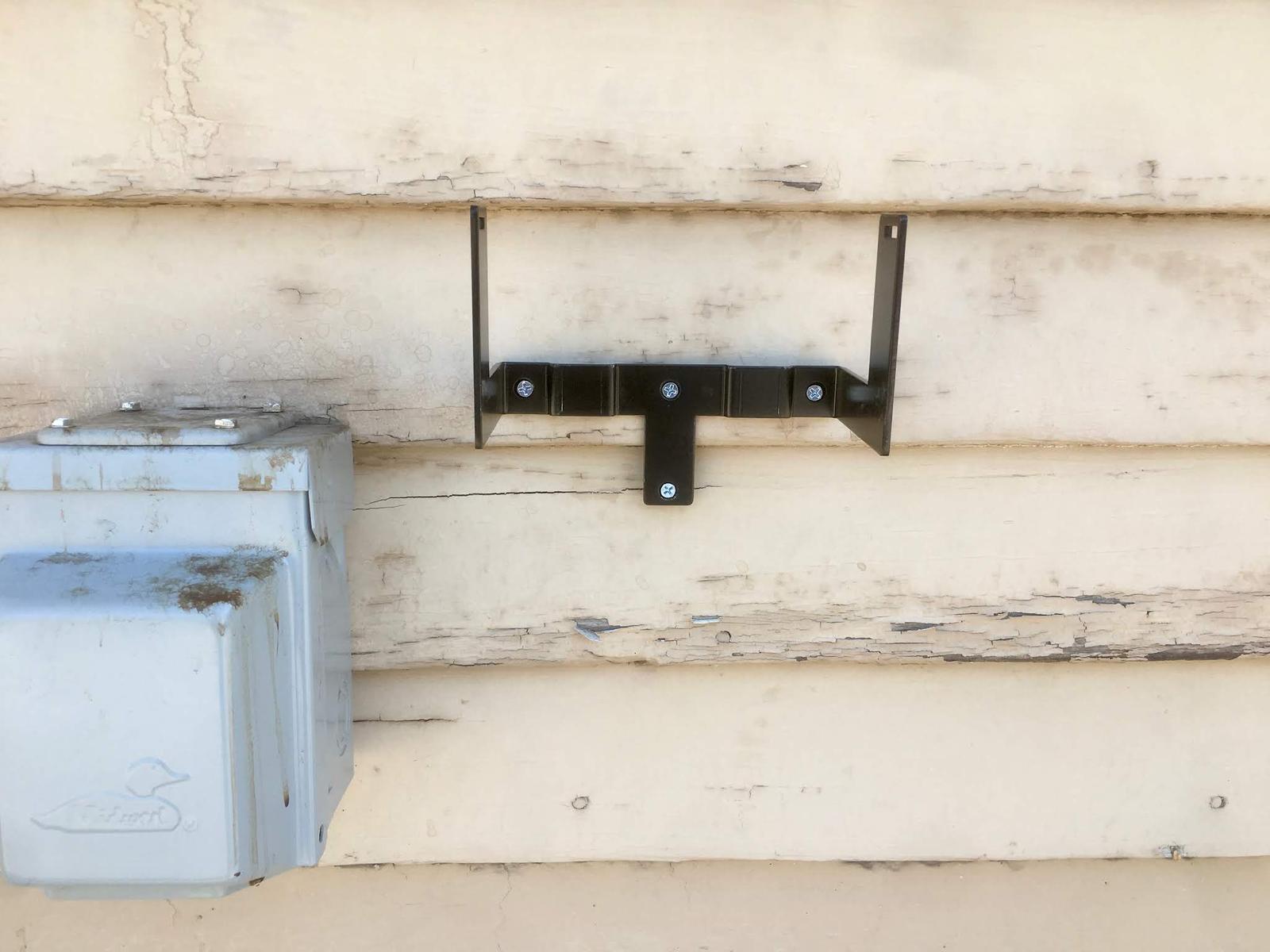
The rear mounting bracket screws to the back of the EVSE, but if you’re playing around with mounting angles to make sure things mount, you might play with it separately for a bit.
Or, for unexplainable reasons, if you order the locking bracket, they send you another backplate - so you can play with one while one is mounted to the actual charger. No idea why.
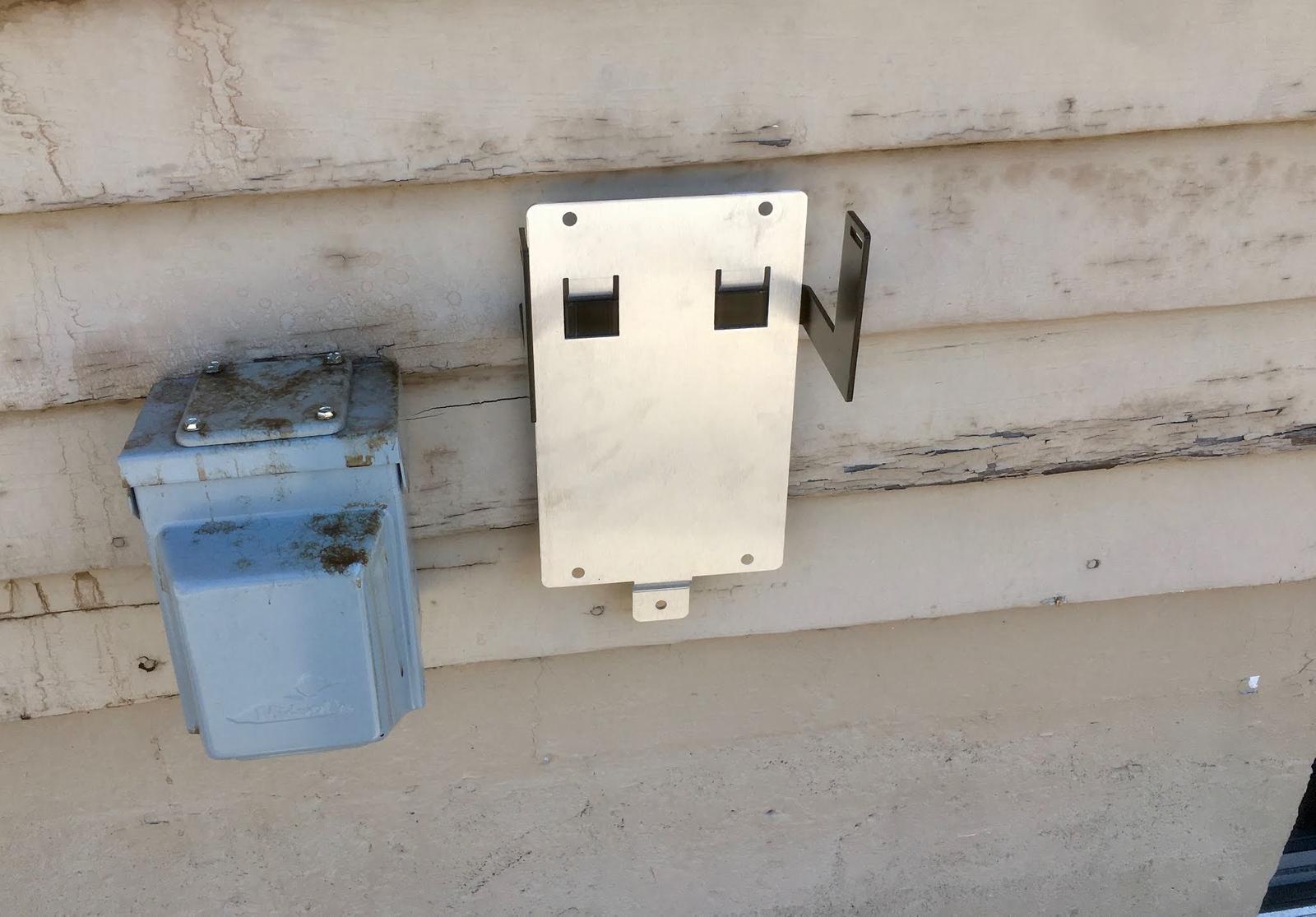
With a bit more work, the whole thing is installed. The EVSE is mounted, locked, and plugged in. The charging cable is looped around a cable holder installed nearby, and I’ve even got the JuiceBox connected to WiFi. It took a power cycle or two for some reason, but I was able to get it connected without too much hassle (for a device with no user interface to speak of - it creates a temporary network you join your phone to, and then give the device the other WiFi network credentials, and… look, could we just agree to expose serial headers and a basic console for something like this? Or a USB port?).
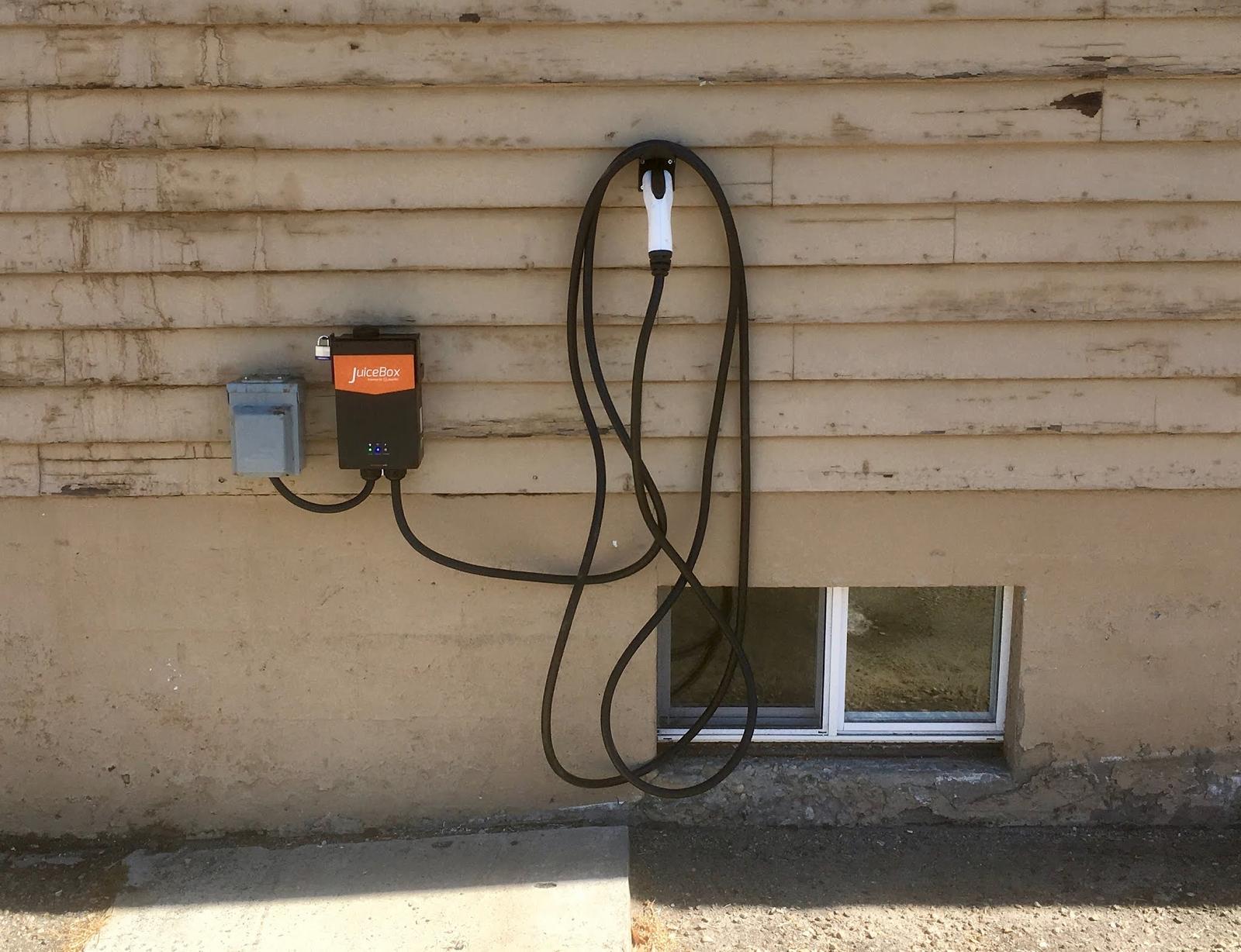
Smoke Test Time!
With everything mounted and hooked up, in theory, it will charge a car now!
Will it?
Aww yeah. Check out that charging! I almost never see 240V charging on our Volt!
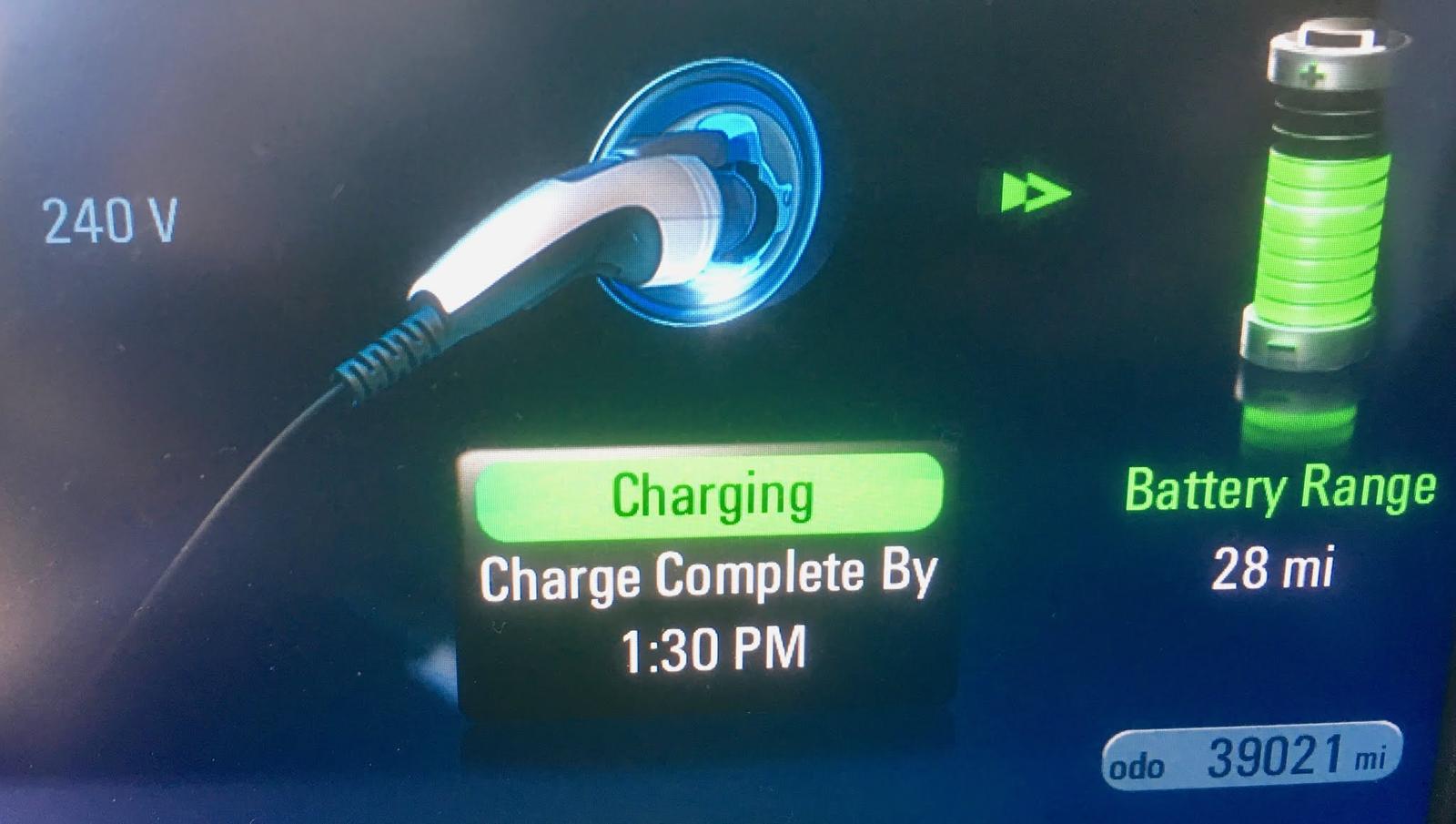
With the JuiceBox app, I can see more or less realtime data from the charger. How fast am I charging? The app tells me, helpfully, that I’m charging at 3.29kW - which, for a 3.3kW charger on the car, sounds about right! Voltage drop is maybe a bit more than I’d like (235V at the EVSE), which is about 2% from a nominal 240V. However, voltage was a bit low even while not charging, so it’s not an issue with the install.
But the charger works!
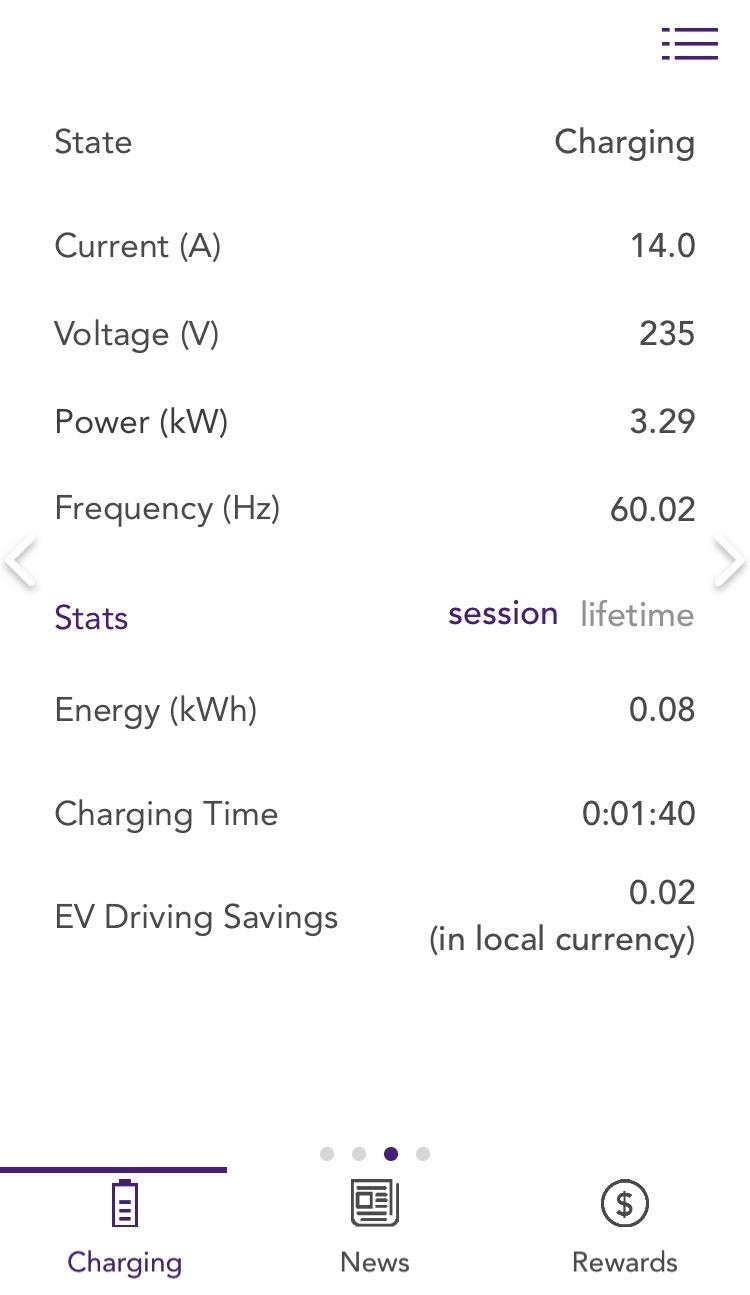
Oh, yeah. The Sign!
In some parts of the world, EV charging stations are common and just about everywhere. Out here? Not as much. And a single JuiceBox doesn’t look like the big tower charging stations over in Boise.
Just to make sure people are clear on what it is (and to advertise a little bit - hey, there’s charging out here!), I’ve added a good EV charging sign. There are a variety of cheap EV charging signs on eBay, so I just picked one that looked good to me.
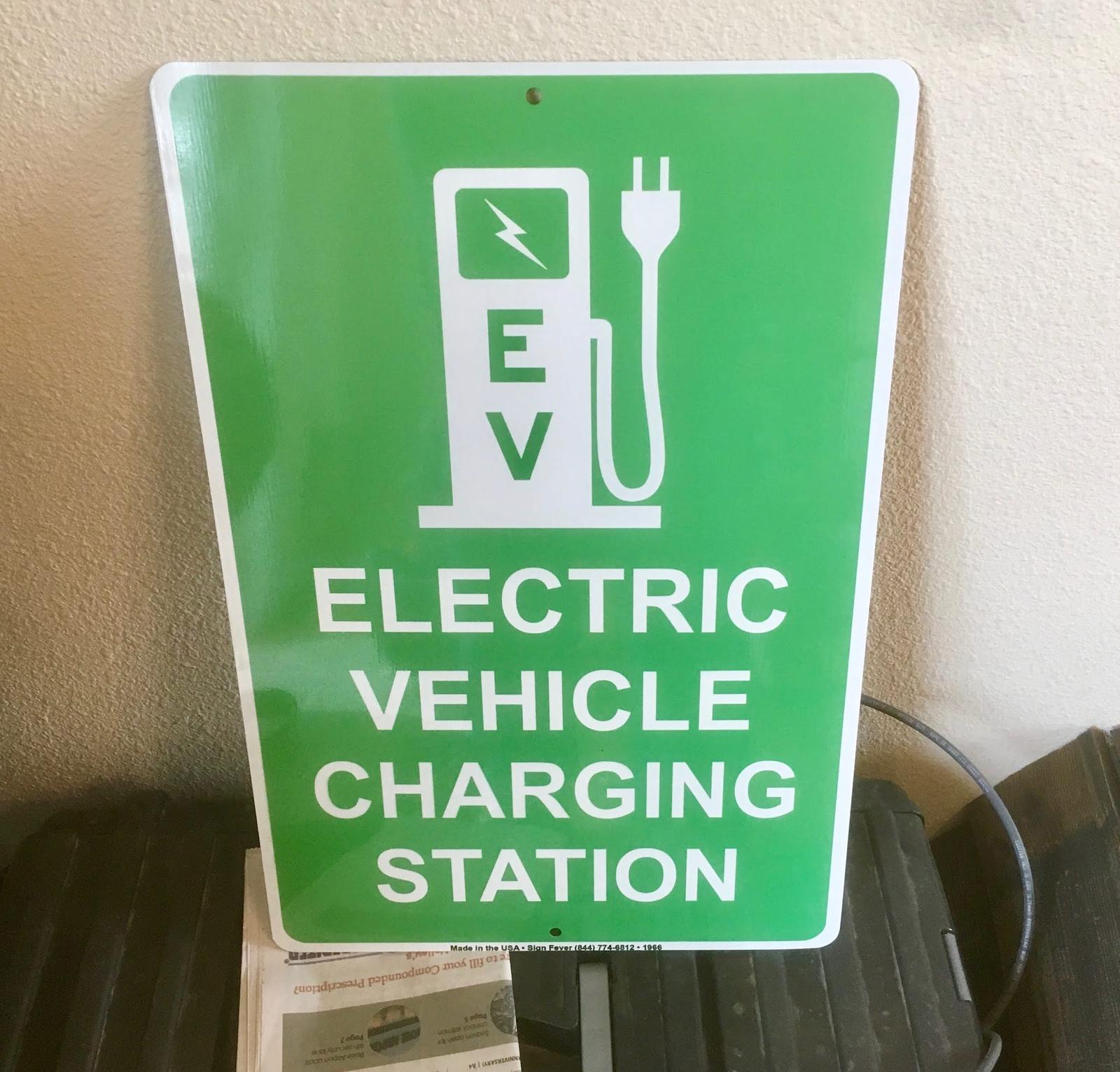
I’m using it to mark the parking spot and the whole assembly. It’s easily visible from the street. Hopefully it brings in some charging!
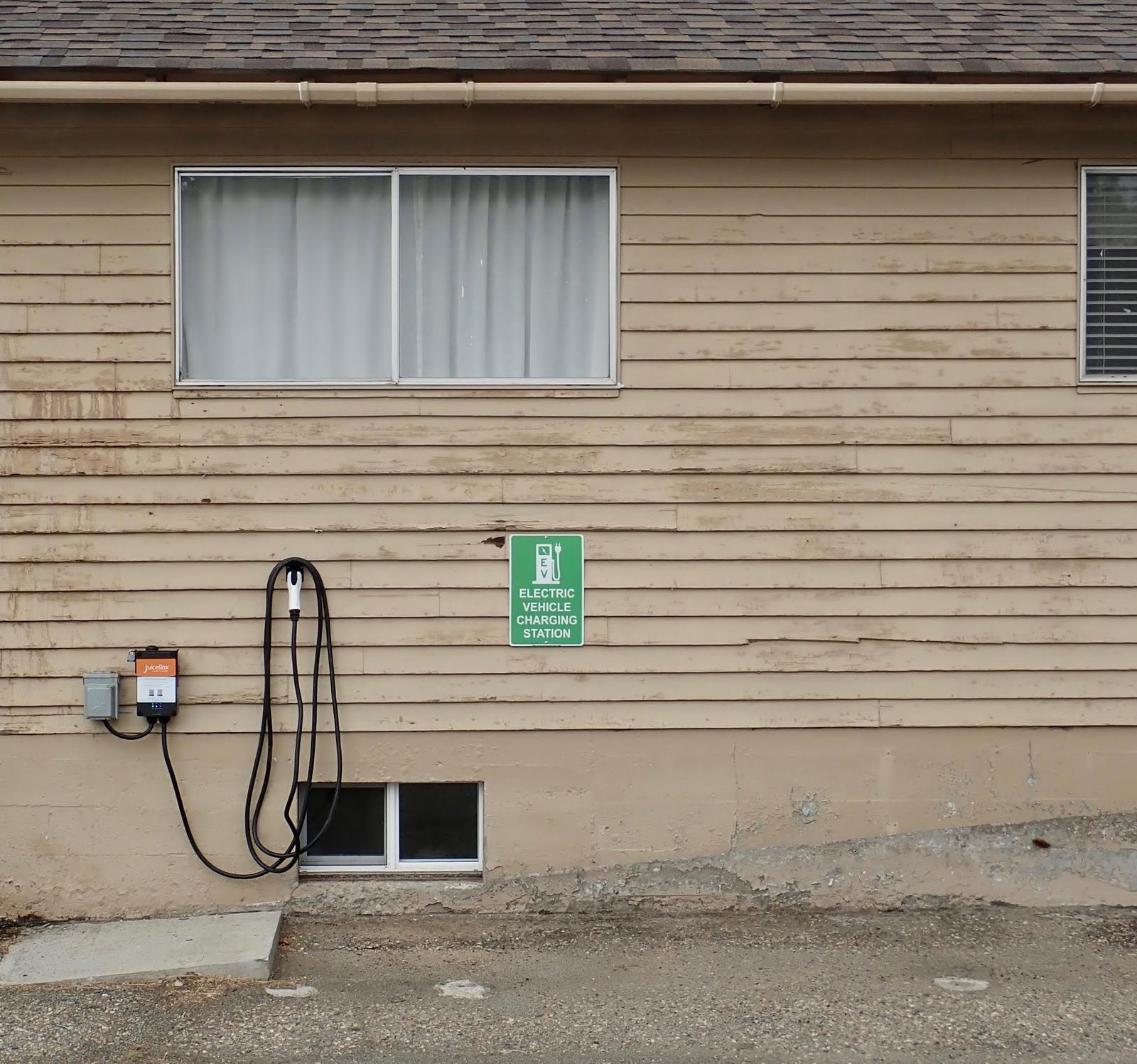
Billing: The Hard Part
For a charger, the physical install is actually the easy part.
The hard part of this whole process was figuring out how to do billing in a sane manner for a charger that, quite honestly, I don’t expect to be used very often (at least initially). If it gets used a few times a month, I’ll be pretty happy! I’ll be even happier if it’s used by someone I don’t actually know in person. A few of us in the church have Volts and that’s likely to be a lot of the initial use.
I had two major goals with the billing solution: Cover our power costs, and not cost me more than just paying for people’s charging out of my own pocket.
Covering the power costs is an obvious goal - our church budget doesn’t include “charging the neighborhood for free.” If it’s just a few people from the church charging, this is easy enough to solve by having them drop a couple bucks in a bowl inside for charging, but that’s not a scaleable solution and it doesn’t work for random people who might want to use it. I considered a bolted-down donation box pretty hard for a while, since I wasn’t finding anything better. I was also debating a big coin-op timer - they exist.
Not costing more than just paying for power is trickier to explain. There are plenty of solutions that are happy to charge a “nominal management fee” to manage EV chargers. These are aimed at businesses, and it’s not hard to spend a few hundred a month on charger management fees before anyone even plugs in once. But even if the fee is only $20/mo, with our power rates being pretty reasonable, that’s 200kWh/mo of power - or an awfully good percent of my monthly power cost for the Volt. If the charging station is getting used for 10 hours a month, at 3.3kW, that’s only 33kWh - so it would be cheaper to just pay for the power than to pay for management fees. For a depressingly wide range of use situations, it’s literally cheaper to pay for the power than the fees.
If you’re a commercial business owner thinking about EV charging stations, do the math on this before you pay a few hundred a month for managed charging. You may be better off just upping your power budget a tiny bit than paying for someone else to charge obscene rates for power (some chargers are north of $0.60/kWh delivered when you do the math - $2/hr on a 3.3kW charger would be there).
I looked through quite a few options that just seemed expensive before I stumbled on one that looked promising: EVMatch.
What’s an EVMatch?
It’s a thing you use to light an EVCandle, of course!
EVMatch (https://www.evmatch.com/) is a company that’s aimed to solve residential charger sharing. You loan out your home charger location (if there’s public access to it) and get credits that can then be used at other people’s shared chargers. Or, for their commercial offerings, you buy charging credits (*grumble*) in the app and the owner of the charging station can get a check payout every so often.
It’s also a reservation based system, not a “first come first serve” system like many of the charging systems out there. If I want to reserve the charger for 3 hours while I wander into Nampa, and nobody else has it reserved, I can block out a time, reserve it, and then the charger is mine for that time. The owner of the charger can approve the reservation, or they can set the charger up with the “instant book” option where reservations within the operating hours are just automatically accepted if there’s no conflict (which is how I have ours set).
Their system interoperates with smart chargers as well. If someone living in the parsonage had an EV and wanted to charge overnight, I could set the system up so they can charge for free nightly, but during the day, the charger is paid public access. It’s really quite flexible, which is very appealing for our somewhat unknown needs.
This is all very nice, but they had some wording in their contact form that really caught my eye.
Interested In Adding EV Chargers At Your Business, Workplace, Or Apartment?
Ask About Our Free Charger Offer
Free charger offer? I’m interested!
A couple emails back and forth later, a bit of some contract signing, and it’s exactly what it says on the tin! I ordered the charger, installed it, got it online in their system, and they sent me a refund check for the cost of the charger and an instruction sticker to go on the charger (it explains how to use EVMatch with a fancy QR code link). In exchange, I use their system for at least a year, and they tossed in a free year of maintenance fees. Because we’re a church, we get a discounted rate on the monthly fees once we have to start paying them in a year.
If this sounds like an absolutely amazing deal to you, it sure sounded like it to me as well!
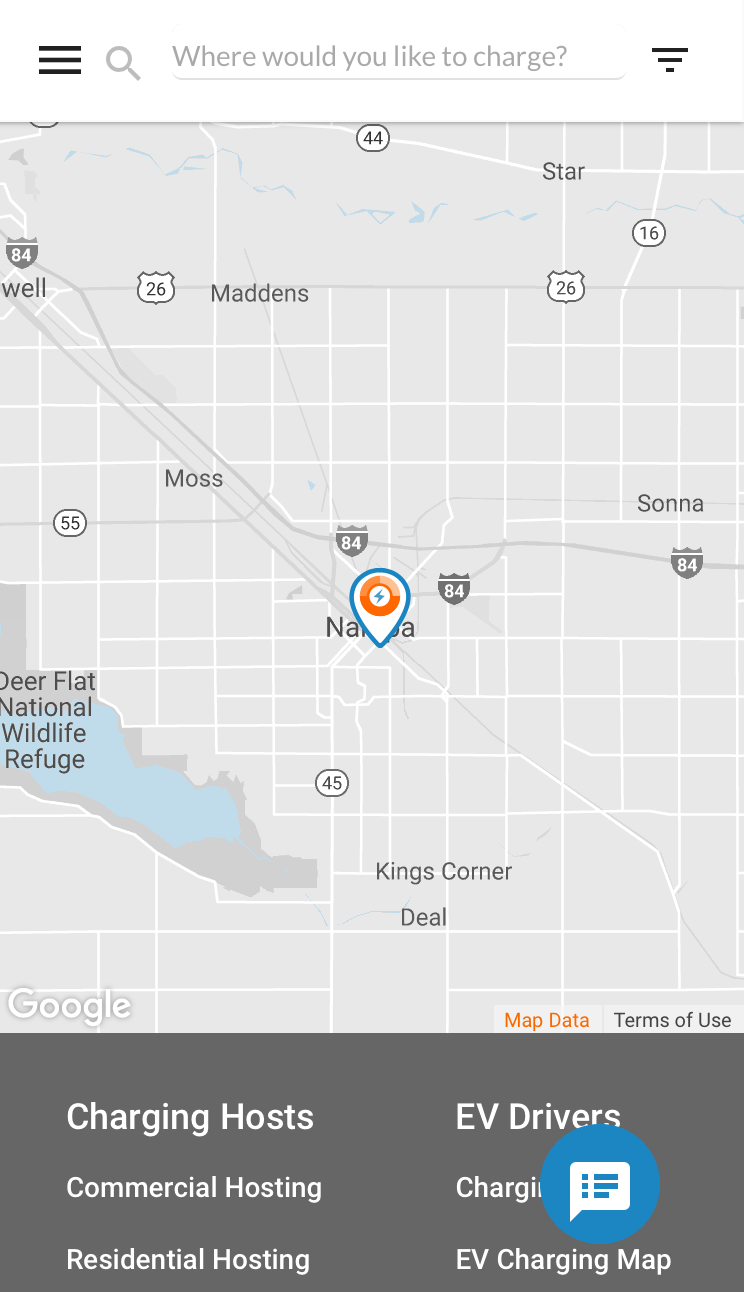
I can configure whatever billing rate I want as well - either a price per hour for charging, or a price per kWh. Because our goal is just to cover power costs, I’ve got it configured at $0.15/kWh. EVMatch adds 20% to what someone pays. I may drop this down a hair in the winter when power is cheaper, but I’ll see where the power bill settles in and what our top tier is - the building is rather power hungry.
There are a few quirks with the system that aren’t obvious at first glance. The first is that you’re not billed for actual power used - you’re billed for the duration of your reservation times the rated charging rate of your car. If I reserve the spot for 2 hours and only charge for an hour, I’ll still be billed for 2 hours at 3.3kW. If the car is full at an hour (or the charge rate is tapering off because it’s nearly full), well, the donation is appreciated. Even at full capacity on the charger (32A), it’s only a bit more than a dollar an hour in power costs, so I don’t think this is going to be a big issue. They do sanity check the peak charge rate and what you’ve said your car draws on the back end, so if you try to claim a 1kW charger on a car that charges at 5kW, they should notice it. Since I can see the charger logs as well, I’m likely to notice too.
Another quirk is that if you show up a bit early, you need to pull out the app and enable the charger - before you plug the car in. Getting close to the reservation time, you can turn the charger on. I’m pretty sure it automatically turns on during the reservation window, but I’m still working out the exact details. I try to get to places early.
Finally, it’s not at all obvious from the website that you buy “packs” of charging credits. You can buy $10 of credits for $10, or $40 of credits for $35 right now. This is annoying for someone who’s just passing through and wants to charge, since they’re stuck with credits they can’t use elsewhere (the nearest EVMatch charger to ours is a few hundred miles away right now). I don’t like the whole “coin pack” approach to purchasing things in the real world like EV charging, but this is what they offer at the moment.

But it’s online, it’s working, and I’ve been able to charge with their system!
If you do sign up for EVMatch, feel free to use my referral code: gWxp4P4 I’d appreciate it, and get some free charging credits out of the deal if all works properly.
Tested and Ready!
I’ve tested the entire pipeline and it seems to work exactly as advertised!
The charger is listed on EVMatch and on Plugshare, and if there are any other common charger-finder sites you use, let me know and I’ll get it added.
I’m excited - this area is quite short on public charging, and I’ve been able to add some!
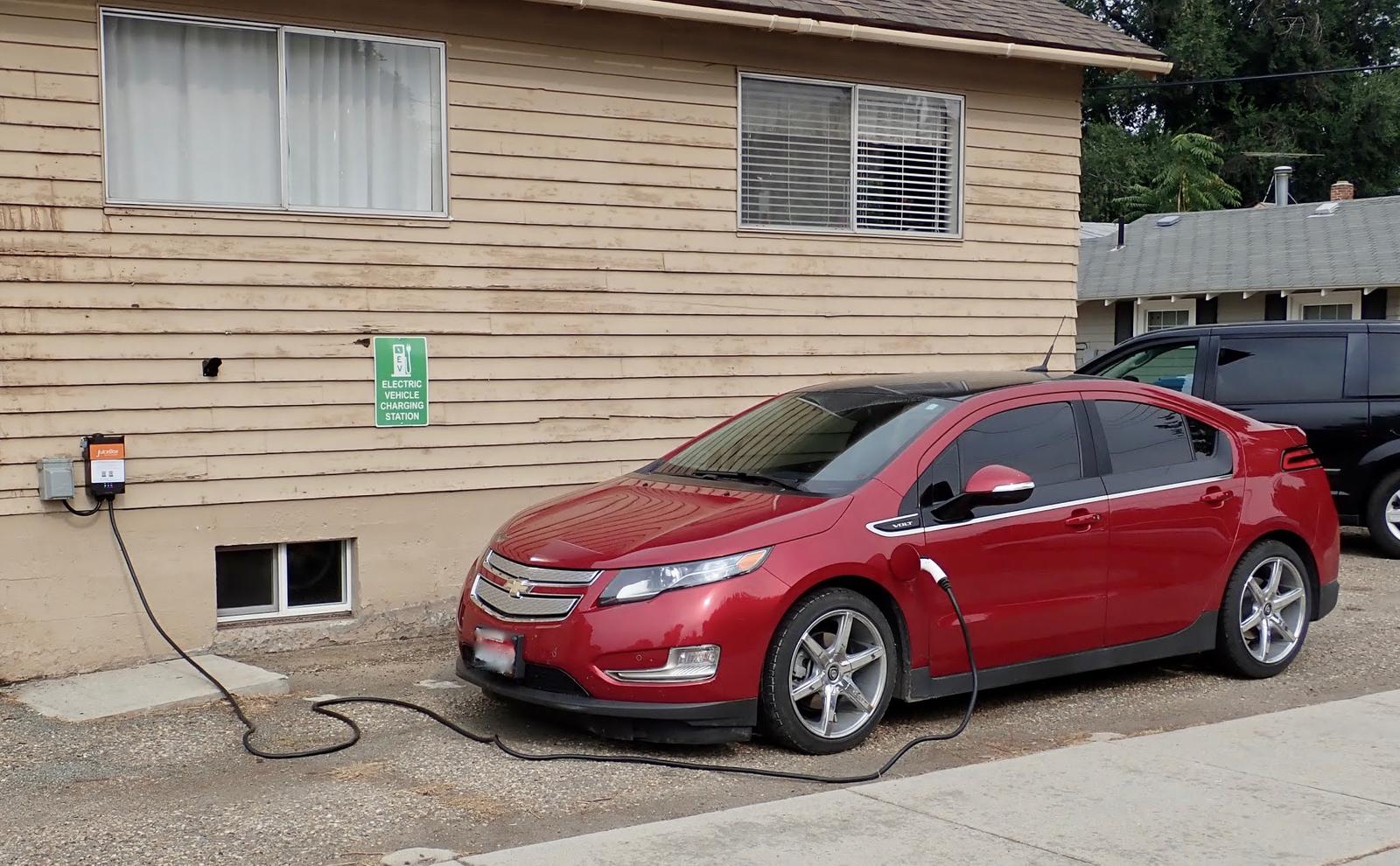
My total cost on the project is under $1000, and almost all of that was getting the outlet installed. I’d been expecting to pay for a charger, but EVMatch’s generous charger offer took care of that! If you’re considering an EV charger and have somewhere accessible, consider getting in touch with them. It’s not a bad deal at all!
And let me know if you decide to do something like this. It’s not that complex a project to tackle, and has the potential to be very useful to a lot of people going forward!
Comments
Comments are handled on my Discourse forum - you'll need to create an account there to post comments.If you've found this post useful, insightful, or informative, why not support me on Ko-fi? And if you'd like to be notified of new posts (I post every two weeks), you can follow my blog via email! Of course, if you like RSS, I support that too.
